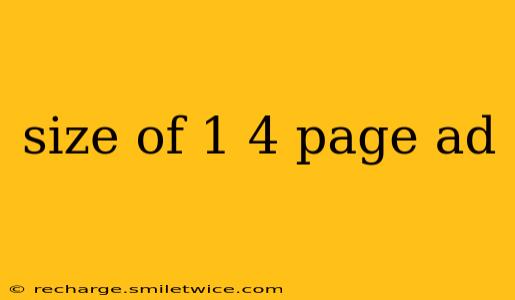Decoding the Dimensions of a 1/4 Page Ad: A Guide to Print Advertising
Understanding the precise dimensions of a 1/4 page ad is crucial for effective print advertising. Unlike digital ads where sizes are easily specified in pixels, print ad sizes are dictated by the publication's page dimensions and the chosen layout. There's no single, universally accepted size for a 1/4 page ad; it varies depending on the publication's format (e.g., magazine, newspaper). This guide will clarify the common dimensions and factors influencing them.
What Determines the Size of a 1/4 Page Ad?
The size of a 1/4 page ad is directly related to the overall page size of the publication. A standard 8.5" x 11" page, for instance, will have a different 1/4 page ad size than a magazine with a larger or smaller page format. The publisher or printing company will provide the specific dimensions for their publication's 1/4 page ad.
Common Scenarios and Approximate Sizes:
While precise dimensions depend on the publication, we can illustrate common scenarios:
-
Standard Magazine (approx. 8.5" x 11"): A 1/4 page ad in a standard-sized magazine might be roughly 4.25" x 5.5" (vertical) or 8.5" x 2.75" (horizontal). However, these are approximations. Always confirm with the publication.
-
Larger Magazine (e.g., a coffee table book): With a larger page size, a 1/4 page ad will also be proportionally larger. Think of a wider and taller version of the standard magazine example above.
-
Newspaper: Newspaper ad sizes are usually measured in columns and inches. A 1/4 page ad in a newspaper could vary considerably depending on the number of columns per page and their width.
How to Find the Exact Dimensions:
The best and most reliable method for obtaining the precise dimensions of a 1/4 page ad is to directly contact the publication's advertising department. They will provide a media kit or rate card containing detailed specifications, including bleed areas (the extra space added beyond the trim size to account for printing and trimming).
Why are Precise Dimensions Crucial?
Using incorrect dimensions can lead to several issues:
-
Wasted Ad Space: Your ad might be too small, resulting in wasted space and reduced impact.
-
Poor Print Quality: Improperly sized artwork can lead to blurry or distorted images.
-
Rejected Ad: Publications may refuse to print ads that don't meet their specifications, leading to delays and extra costs.
Bleed and Trim Sizes: Understanding the Difference
-
Trim Size: This refers to the final size of the page after printing and trimming.
-
Bleed: The bleed area extends beyond the trim size, ensuring that even after trimming, the intended design reaches the edges of the page. Failure to include bleed can result in white margins around your ad. The publication will specify the required bleed amount.
What if I Design My Ad Before Getting the Dimensions?
It's best practice to obtain the specifications before you start designing your ad. However, if you've already created your design, you can adjust it based on the information you receive from the publication's advertising department. Some design software allows for easy resizing and maintaining aspect ratios.
By carefully considering these factors, you can ensure your 1/4 page ad is printed correctly and effectively communicates your message. Remember, precise dimensions are paramount for a successful print advertising campaign.
